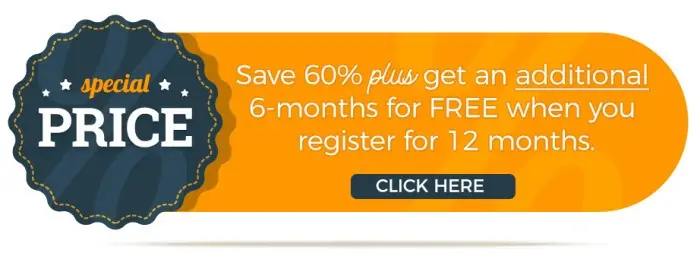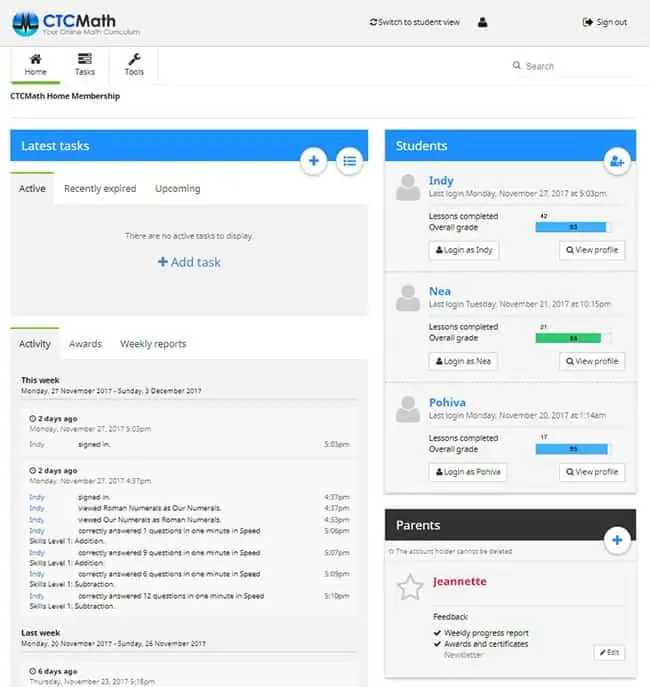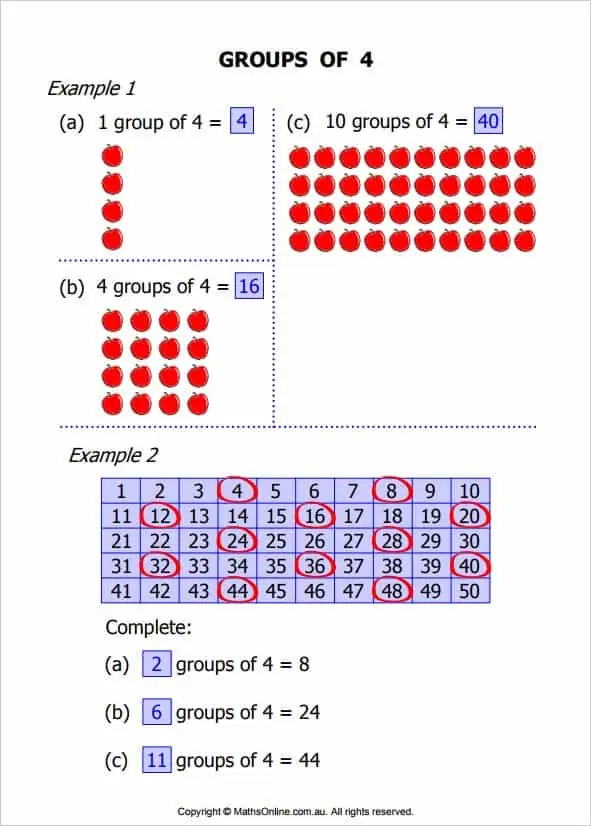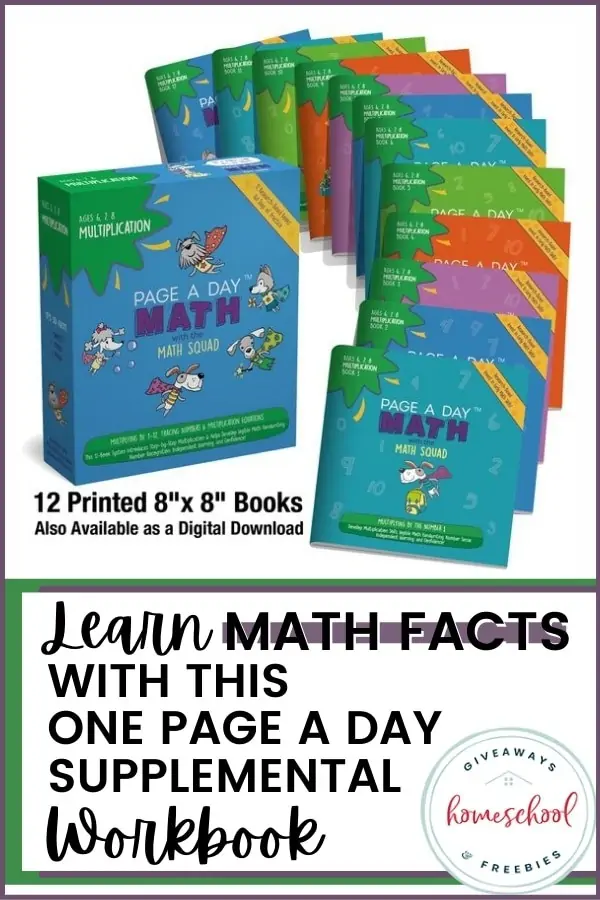Using CTC Math with 3 Different Learning Styles
Published:
January 2, 2018
Contributor:
Jeannette Tuionetoa
Disclosure: This post may contain affiliate links, meaning if you decide to make a purchase via my links, I may earn a commission at no additional cost to you. See my disclosure for more info.
We used CTC Math with 3 different children – two of which cannot sit still for more than a minute, one of them has a learning disability, and the third child is a super over-achiever. I am excited to share with you how CTC Math worked for us.
Access to CTC Math was given to me in exchange for my honest opinion. I was not required to write a positive review. All opinions are my own.
If you are interested in CTC Math and would like to save money, you can get a 60% discount + an additional 6-months for FREE when you register for 12 months. If you plan it right, you could basically get 2 school years (9 months each year) for the price of 1…FOR YOUR ENTIRE FAMILY! Click this special link for the savings.
The Basics
CTC Math is an online, subscription-based full math curriculum for grades K – 12. It was created and taught by a math teacher named Pat Murray who has been teaching for 31 years. He has 5 boys and 5 girls, which gives him some parenting cred in my book- check (√).
After registering your child in CTC Math, you can then choose their educational stage (i.e. Elementary, Junior/Middle School or High School). From selecting the educational stage, you can select a grade level, then a category (i.e. Basic Math and Pre-Algebra, Elementary Geometry, Measurement etc.). The grade levels are specific for K – 6 and High School, however aside from these specific grades, there are general categories like Algebra 1, Geometry, Trigonometry etc. It is slightly hard to describe, but once you see it, it makes sense.
Grades K – 6 have specific topics to go through – Number/Patterns/Algebra, Measurement, Space/Geometry and Statistics/Probability. After Grade 6, the topics are split into parts (part 1,2,3, etc.). Once you select a topic, you have an option to give your learner 20, 30 or 40 question, diagnostic tests before or at the end of the lesson. I usually use 20 questions with my active child and 40 for my overachiever, for obvious reasons. This diagnostic, if used before the lesson, can you give you an idea of your child’s knowledge of a particular, lesson topic (see photo below).
It is good to know that CTC Math is not a stare climb curriculum where you must complete one lesson before you can go on to the next. You truly have unlimited access to all the lessons, across all grades. If your child is more advanced or behind in a category or topic, the flexibility for a parent to assign specific tasks makes CTC Math very workable and logical.
Parents
Parents are given their own login. From the parent page, you can assign tasks, view learner activity on the site, view awards your child has been given, and review weekly reports of their grades. You can view this information for each of your learners, along with their overall grade, and lessons completed. It is a one-stop-shop to get all the information you need on your child’s progress. Although you can select what is a passing score (i.e. 70 out of 100, 80 out of 100, etc.) during registration of the learner, you can also change/update this on the parent page at any time.
Every learner is given their own login so that the program can track their progress. The parents can view each student’s progress from their parent login at any time as well.
Placement tests were really important to me when looking for a Math curriculum. I honestly didn’t know what level my children needed to be in after leaving public school. I knew what grade level they were in for public school, but I knew little of what they learned, what they didn’t learn, or even where to begin.
As mentioned above, CTC Math allows for diagnostic (standard and comprehensive) tests for each topic giving parents an idea of where their learner is in an area. You can use it as a pre-test or to check learning after a lesson. These really helped me with a starting point for my kids. It also helps me know what lesson we can pass over and which they need to start from ground zero.
If a lesson was particularly difficult for my kids, I had no problem letting them complete another less stressful lesson, which helped build their confidence. Just to be real, I am relieved to not have to follow a rigid mastery curriculum to count our children as successful. My son does well when I work within his ability, bit by bit. Being able to go through the curriculum to any grade level gives us the freedom to do this. It works well for us.
How Lessons Work
In the tutorials, Pat uses simple language and a clear voice, which isn’t too monotone or overly annoying. You can rewind the tutorial lessons as much as you would like or as often as your child needs to. The tutorials provide practice for students before they complete the lesson questions, which takes some pressure off the test taking anxiety that some children may have.
The interactive lessons literally take your child step-by-step through the learning. For some, this may be too basic, but even my daughter (the overachiever) tries to go straight to the diagnostic test sometimes, just to find that she needed to go through the tutorial. So, it helps!
The most important thing to note (at least for us) is that the lessons are NOT long. Having a hyperactive child who struggles to sit still makes long lessons very daunting. Therefore, clear and quick lessons, with the option to rewind, are a plus to CTC Math.
Following each tutorial are interactive questions or an optional printable worksheet that tests the understanding of what was taught. If your child likes hardcopies to have as a reference, there is a printable summary for each lesson. The summary is only one page which helps if you are trying to save on ink. See image below as an example:
If your child attempts all lessons in a topic, they earn a certificate of completion for that topic (silver, gold or bronze depending on the passing scores you set out for them upon registration).
The Skinny
We initially selected CTC Math because out of all the voices in voice-over tutorials from different math curricula that we trialed, CTC Math was the only voice that our son could tolerate. Point blank; that is the main reason we chose this specific curriculum above all the rest. We listened to a bunch of trial tutorials and he could only tolerate Pat’s voice. So, it went something like this, “no, no, no, no way, no, yes, no, no, nope, no”. CTC Math was the “yes”.
To be specific about my son, his attention span is very short. He is never in one space for too long. To learn pronouns, we have to do the craziest things or jesters/dances and record oursleves holding up the word to associate the word with something to remember it by. It is pretty hilarious. It is so awesome to see how his brain works, and so that is why CTC Math works for him. He hears a voice that isn’t too boring or annoying for him to tolerate, the instructions are clear; they are given AND shown simultaneously… step by step.
The questions after the lessons had him a little frazzled at first, since he is not good with typing the answers. So, what we did was sit with him in the first few lessons. He would say his answer aloud and I would type his answer for him. As a mom, you all know how we have to adjust things like this for our children, especially when they learn differently than others. It’s just what we do. And that is ok, mom. Just like our lives do not look the same as someone else’s, our children’s way of learning will not look the same either. However, homeschooling gives you flexibility. So, to take that pressure off yourself and see what works for your child.
Any lesson over 15 minutes for our hyperactive kids is just too much, so these simple lessons really work well for them. My daughter, the overachiever, can’t stand getting one answer wrong, so she will choose to go back over a tutorial to get a better grade. So, CTC Math works well for all types of learners.
Your student can literally learn at their own pace and move up and down levels as necessary. I say down levels, because my daughter skipped some lessons and noted that she had to go back to learn the basics to move forward, which is great because we discovered some learning gaps prior to using CTC Math.
One can tell that, because of these things, the curriculum is for all learners of all abilities… to strive to reach their full potential. The tutorials don’t take too long to explain things, meaning the explanations for the lessons are short; they are about 4-9 minutes. Even if the learner doesn’t grasp the concept right away, they can return to the tutorial and immediately put it into practice.
Price
I know how hard it is to afford yearly subscriptions, trust me I have been there. However, if I am being honest, a yearly family subscription is the best deal you can get. There are other plan options that CTC Math offers. They have monthly, six-monthly and yearly plans for both single student memberships and family memberships. Family options are especially helpful for teachers who plan to use CTC in their classrooms for particular students or for 2+ kids in homeschooling families.
A few additional kudos for CTC Math:
- It isn’t too chaotic. Basically, the system is really easy to maneuver through. Since two of our children are easily distracted, it is really nice that the screen view is simple. There aren’t any extreme colors or useless computer graphics or noises/pop-up praises taking their attention away from the lesson. So, if you have a child that is easily distracted, CTC Math’s set-up helps keep your child’s focus on the lesson and not obnoxious icons/graphics that can capture their attention.
- Builds your child’s confidence. Since the child is able to see his/her own grades and how they are tracking along, there is motivation to do better. They are not compared to anyone, but themselves and, therefore, can challenge themselves to do better.
- Speed skills/games rock! At the bottom of the page of each lesson, there are three (3) links to click on for extra help and fun. One is Speed Skills where questions are timed to improve how fast your child can do certain skills. The next is Times Tables which tests your child’s skills in sharpening their times table skills. The last is a game called Swap Pieces, which is super tricky. My daughter hasn’t been able to master it, yet. Anyway, these are great as extra daily practice or after a lesson. The kids find it fun. At first, if your child gets some anxiety with test taking, it could be overwhelming for them, but in time and as they improve, it really is fun for them.
A few things to think about:
- For children who like to ‘hear’ the questions aloud, you should know that not all questions are voiced over. I am unsure why some questions have an audio icon/graphic, and some don’t. Having a dyslexic child, I wish all questions were audible.
- There is only one lesson per topic. So, if your learner doesn’t understand the lesson after hearing the tutorial a few times, then you might have to obtain some supplemental material to fill that gap or for full understanding.
We have decided to stick with CTC Math for our special kids; the hyperactive child, the hyperactive/dyslexic child and our overachiever. Why? Because, probably like you, our normal doesn’t look like everyone else’s normal. And this particular curriculum works well with all of the kids, for different reasons, in a very normal and logical way.
You can learn more about how CTC Math works here and you can sign up for a FREE trial here.
If you are interested in CTC Math and would like to save money, you can get a 60% discount + an additional 6-months for FREE when you register for 12 months. If you plan it right, you could basically get 2 school years (9 months each year) for the price of 1…FOR YOUR ENTIRE FAMILY! Click this special link for the savings.












